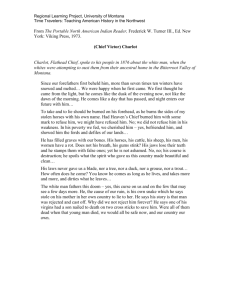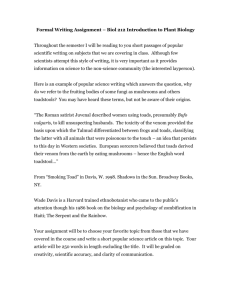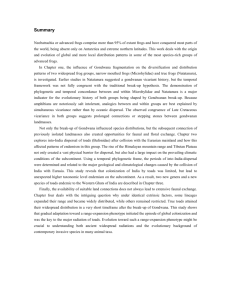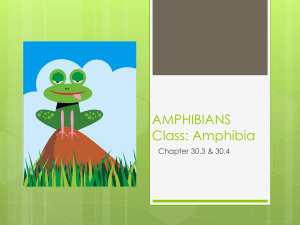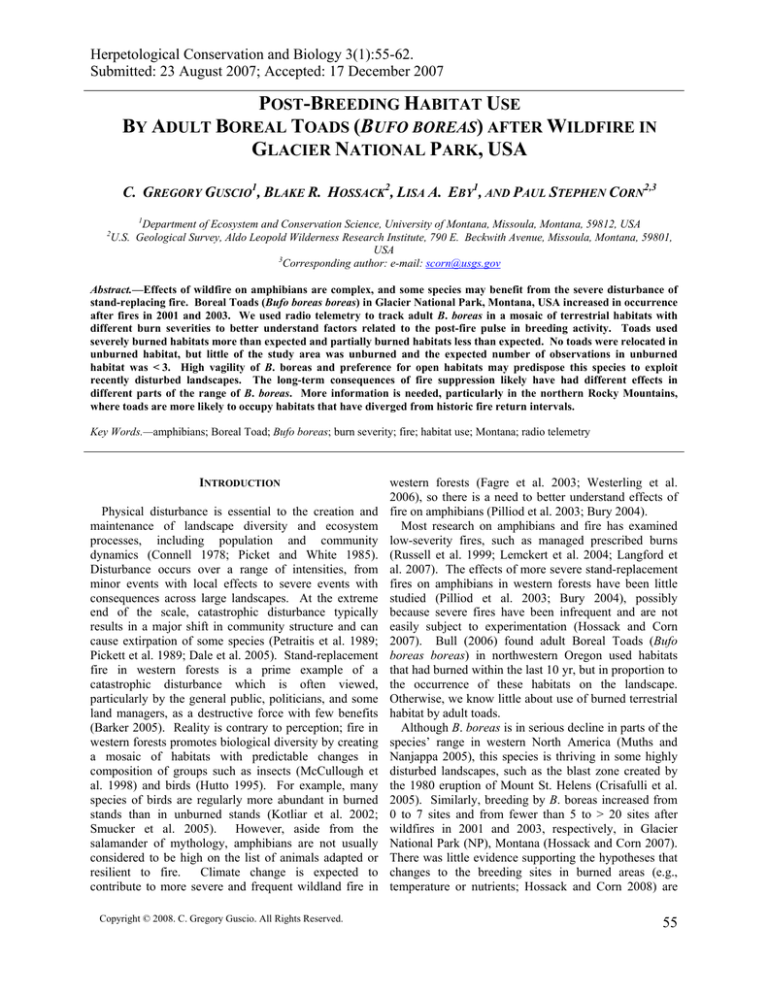
Herpetological Conservation and Biology 3(1):55-62.
Submitted: 23 August 2007; Accepted: 17 December 2007
POST-BREEDING HABITAT USE
BY ADULT BOREAL TOADS (BUFO BOREAS) AFTER WILDFIRE IN
GLACIER NATIONAL PARK, USA
C. GREGORY GUSCIO1, BLAKE R. HOSSACK2, LISA A. EBY1, AND PAUL STEPHEN CORN2,3
1
Department of Ecosystem and Conservation Science, University of Montana, Missoula, Montana, 59812, USA
U.S. Geological Survey, Aldo Leopold Wilderness Research Institute, 790 E. Beckwith Avenue, Missoula, Montana, 59801,
USA
3
Corresponding author: e-mail: scorn@usgs.gov
2
Abstract.—Effects of wildfire on amphibians are complex, and some species may benefit from the severe disturbance of
stand-replacing fire. Boreal Toads (Bufo boreas boreas) in Glacier National Park, Montana, USA increased in occurrence
after fires in 2001 and 2003. We used radio telemetry to track adult B. boreas in a mosaic of terrestrial habitats with
different burn severities to better understand factors related to the post-fire pulse in breeding activity. Toads used
severely burned habitats more than expected and partially burned habitats less than expected. No toads were relocated in
unburned habitat, but little of the study area was unburned and the expected number of observations in unburned
habitat was < 3. High vagility of B. boreas and preference for open habitats may predispose this species to exploit
recently disturbed landscapes. The long-term consequences of fire suppression likely have had different effects in
different parts of the range of B. boreas. More information is needed, particularly in the northern Rocky Mountains,
where toads are more likely to occupy habitats that have diverged from historic fire return intervals.
Key Words.—amphibians; Boreal Toad; Bufo boreas; burn severity; fire; habitat use; Montana; radio telemetry
INTRODUCTION
Physical disturbance is essential to the creation and
maintenance of landscape diversity and ecosystem
processes, including population and community
dynamics (Connell 1978; Picket and White 1985).
Disturbance occurs over a range of intensities, from
minor events with local effects to severe events with
consequences across large landscapes. At the extreme
end of the scale, catastrophic disturbance typically
results in a major shift in community structure and can
cause extirpation of some species (Petraitis et al. 1989;
Pickett et al. 1989; Dale et al. 2005). Stand-replacement
fire in western forests is a prime example of a
catastrophic disturbance which is often viewed,
particularly by the general public, politicians, and some
land managers, as a destructive force with few benefits
(Barker 2005). Reality is contrary to perception; fire in
western forests promotes biological diversity by creating
a mosaic of habitats with predictable changes in
composition of groups such as insects (McCullough et
al. 1998) and birds (Hutto 1995). For example, many
species of birds are regularly more abundant in burned
stands than in unburned stands (Kotliar et al. 2002;
Smucker et al. 2005). However, aside from the
salamander of mythology, amphibians are not usually
considered to be high on the list of animals adapted or
resilient to fire.
Climate change is expected to
contribute to more severe and frequent wildland fire in
Copyright © 2008. C. Gregory Guscio. All Rights Reserved.
western forests (Fagre et al. 2003; Westerling et al.
2006), so there is a need to better understand effects of
fire on amphibians (Pilliod et al. 2003; Bury 2004).
Most research on amphibians and fire has examined
low-severity fires, such as managed prescribed burns
(Russell et al. 1999; Lemckert et al. 2004; Langford et
al. 2007). The effects of more severe stand-replacement
fires on amphibians in western forests have been little
studied (Pilliod et al. 2003; Bury 2004), possibly
because severe fires have been infrequent and are not
easily subject to experimentation (Hossack and Corn
2007). Bull (2006) found adult Boreal Toads (Bufo
boreas boreas) in northwestern Oregon used habitats
that had burned within the last 10 yr, but in proportion to
the occurrence of these habitats on the landscape.
Otherwise, we know little about use of burned terrestrial
habitat by adult toads.
Although B. boreas is in serious decline in parts of the
species’ range in western North America (Muths and
Nanjappa 2005), this species is thriving in some highly
disturbed landscapes, such as the blast zone created by
the 1980 eruption of Mount St. Helens (Crisafulli et al.
2005). Similarly, breeding by B. boreas increased from
0 to 7 sites and from fewer than 5 to > 20 sites after
wildfires in 2001 and 2003, respectively, in Glacier
National Park (NP), Montana (Hossack and Corn 2007).
There was little evidence supporting the hypotheses that
changes to the breeding sites in burned areas (e.g.,
temperature or nutrients; Hossack and Corn 2008) are
55
Herpetological Conservation and Biology 3(1):55-62.
influencing this increase in use. Thus,
changes to the terrestrial environment may
be playing a role in driving this change in
breeding site distribution. Parallel to the
studies of amphibian breeding sites
following the wildfires of 2001 and 2003 in
Glacier NP (Hossack and Corn 2007), we
studied adult B. boreas (Fig. 1) in the
mosaic of burned and unburned terrestrial
habitats on the west side of Glacier NP. We
compared use of habitat mosaics from
severely burned to unburned to better
understand factors related to the post-fire
pulse in breeding activity.
METHODS
Study Area.—The Robert Fire, a standreplacement wildfire, burned about 16,500
ha on the west side of Glacier NP, Montana,
USA in July and August, 2003 (Fig. 2, 3;
Hossack et al. 2006a). Most of the study
area was covered with dense stands of
FIGURE 1. Boreal Toad (Bufo boreas boreas) in Glacier National Park, Montana,
Lodgepole Pine (Pinus contorta) and
USA. Photographed by Blake R. Hossack, USGS.
Western Larch (Larix occidentalis) with a
historical fire frequency of 140-340 yr
considered a stand-replacing fire, typical for the region,
(Barrett et al. 1991). The southeastern portion of the it burned with mixed severity (Fig. 3). Within the fire
study area was dominated by Western Redcedar (Thuja perimeter, 24% of the area burned at high severity, 57%
plicata)-Western Hemlock (Tsuga heterophylla) forests of the area was partially burned, and 19% of the area
with mean historical fire return intervals of up to 450 yr was unburned. The study sites were located in an area of
(Barrett et al. 1991). The initiation date of stands in the relatively higher fire severity. Of the 849.8 ha within the
study area ranged from 1628 to 1926 (Barrett et al. three study sites (92.7 ha were covered by the surface of
1991).
Lake McDonald outside the fire perimeter), 24.1 ha
We characterized habitat and use by B. boreas at three (2.8%) were unburned, 448.4 ha (52.8%) were partially
study sites within the study area. Each study site burned, and 377.3 ha (44.4%) were severely burned.
consisted of a central wetland or pair of wetlands used
for breeding by ≥ six toads and the surrounding
Vegetation Sampling.—To measure differences in
terrestrial habitats within 1 km of the wetland center vegetation and structural characteristics among burn
(Fig. 3). We used a GIS with a burn severity data layer severity classes that may influence habitat use by toads,
provided by Carl Key (USGS, Glacier National Park, we sampled 36 systematically selected plots divided
West Glacier, MT) to quantify the area within each study evenly among the three burn severity classes, in each of
site according to three fire severity categories: unburned three study sites (Fig. 3). These plots were associated
(no evidence of fire); partially burned (some unburned with a complementary study and do not necessarily
understory or canopy foliage present); and severely represent the distribution of vegetation characteristics
burned (no unburned foliage present). These are fewer across the landscape, but they should accurately
than the burn severity classifications available in the data characterize the differences in general habitat
layer, but it was difficult in the field to distinguish characteristics among our fire severity categories. At
reliably among intermediate burn categories. Therefore, each of the 108 vegetation plots, we used a moosehorn
for accuracy, and to maximize the contrast in our densitometer to evaluate the presence or absence of tree
analysis, we combined low and moderate burn severities canopy, shrubs, forbs, grasses, groundcover, downed
as partially burned.
wood, and bare ground at 21 points within a 5-m radius
Burn severity classifications are based on the fire’s circle. Data for each plot were summarized as the
effect on vegetation and soils, determined by combining proportion of the 21 points that contained each
indices derived from satellite imagery and field plots vegetation or cover type. These measurements were
(Key and Benson 2005). Although the Robert Fire is
taken toward the end of the 2004 field season and reflect
the regrowth that occurred during the 12 months after the
56
Guscio et al.— Habitat Use by Bufo boreas after Wildfire
FIGURE 2. The Robert Fire burns on Howe Ridge, across Lake
McDonald in Glacier National Park, Montana, USA on 10 August 2003.
Photographed by USGS.
fire. The vegetation data were summarized using
Principal Components Analysis with varimax rotation on
the correlation matrix to reduce the seven measures into
orthogonal axes.
Habitat Use.—We captured 22 adult B. boreas (6-8
per study site) in May and June 2004, fitted each one
with a Titley Electronics LT-2 radio transmitter (Ballina,
NSW, Australia), and measured mass and snout-vent
length (SVL). One toad was initially fitted with a
transmitter in late July, 2004. We affixed transmitters
using adjustable Velcro waist belts (David
Schmetterling, pers. comm.). The smallest toad fitted
with a transmitter was 34 g. Transmitters with belts
averaged 2 g. We attempted to relocate each toad at
least once every 3-5 days during the daytime using a
Communications Specialists R-1000 receiver
(Orange, CA, USA) with a Telonics RA-14 antenna
(Mesa, AZ, USA). The effective range of these
transmitters was 100-300 m in our study area.
Relocations typically included visual contact unless
an animal was in a burrow or thick vegetation. We
recorded burn severity, microhabitat (under log, in
burrow, open, in vegetation), and air temperature
during each relocation event.
We restricted
relocations to daytime hours to minimize
opportunities for hazardous encounters with bears.
We recaptured toads at least once every 15 days to
evaluate the fit of their waist belts and to check the
health of the animals. If toads developed sores from the
waist belts, we treated them with Bactine and their belts
were adjusted to prevent further abrasion. If no radio
signal was detected during a relocation attempt, we
repeatedly searched outward from the last known
FIGURE 3. Study sites used in evaluating responses of Bufo boreas to wildfire in Glacier National Park, Montana, USA. Black circles represent 1km radii centered on breeding pond(s) where toads were initially located. Site numbers 1, 2, and 3 (from south to north) are overlain on a Robert
Fire burn severity map.
57
Herpetological Conservation and Biology 3(1):55-62.
TABLE 1. Variable loadings and the eigenvalues (λ) of the first 2
factors summarizing vegetation characteristics that were measured in
108 plots. The data were summarized using Principal Components
Analysis with varimax rotation of the correlation matrix.
Variable
Bare ground
Ground cover
Shrubs
Forbs
Canopy
Grasses
Downed wood
λ
Factor 1
Factor 2
-0.90
0.88
0.80
0.72
0.68
0.31
-0.06
3.31
-0.21
0.27
0.26
-0.43
0.45
0.74
-0.72
1.62
location of an animal in concentric circles, increasing the
radius by about 200 m with each circle. Beginning in
mid-August, we recaptured animals and removed the
transmitters.
because observations on the six females were
comparatively rare (mean = 2.4 observations, range = 16) compared to those of the eight males (mean = 12.4
observations, range = 5-17).
We followed this initial comparison of use versus
availability of different burn severities with a Logistic
Regression analysis (α = 0.05) to determine whether use
of partially and severely burned habitats was dependent
upon time (ordinal date) or microhabitat use. Ordinal
date was correlated (r = 0.57) with mean daily air
temperature 6-km away at the West Glacier remote
automated weather station (Desert Research Institute
and the West Regional Climate Center. National Parks
RAWS
Page.
Available
fromhttp://www.wrcc.dri.edu/wraws/nidwmtF.html
.
[Accessed 15 January 2008].), and provided a better fit
to the data than the weather station data (temperature,
relative humidity, or precipitation). We included a
microhabitat × ordinal date interaction term because we
hypothesized that diurnal use of severely burned areas
later in the season would be facilitated by decreased use
of open microhabitats. We also included the three study
sites as a blocking factor because the availability of burn
severities was not equal in each and because toad
behavior may have differed depending upon local
microclimate.
Analysis.—Eight toads did not contribute any
terrestrial observations; three died shortly after the
transmitters were attached, and five either were never
relocated after the initial capture or freed themselves
from their transmitter before any terrestrial relocations
were made. We excluded relocations of toads in water,
which were rare after toads left the breeding ponds.
Consequently, our analysis was based on 112 terrestrial
RESULTS
observations from 14 toads (1-17 observations per toad,
mean = 8.0) between the dates of 20 May and 17 August.
Vegetation and structural characteristics differed
Days between observations averaged 4.3 (range = 1-17).
The data were analyzed as a Design I study, where all among areas with different fire intensities (Fig. 4).
observations were considered independent and there
was no analysis of use by individual animals (Neu et al.
1974).
We evaluated time and temperature trends in
microhabitat use before testing whether toads used burn
severities in proportion to their availability because we
expected that use of microhabitats and burn severities
were correlated. We grouped microhabitats into cover
(log or burrow, n = 28), vegetation (grass or shrub, n =
50), and open (n = 33) categories for analysis and used
1-way ANOVA (α = 0.05) to test whether ordinal date
and air temperature recorded during relocations
differed among microhabitats. We analyzed expected
and observed use of the different burn severities using
program Resource Selection for Windows (Fred Leban,
University of Idaho, Idaho, USA), which weighted
availability and use of each burn severity by the
number of telemetered animals in each of the three
study sites. We compared observed and expected use
using Bailey simultaneous 95% confidence intervals
(Cherry 1996). Because no toads were relocated in
unburned habitats, we first rescaled the partially and
FIGURE 4. Values from the 108 vegetation plots plotted in principal
components space. Points from each of the 3 fire severity classes are
severely burned categories to sum to 1 and based our
encompassed by a minimum convex polygon. See Table 1 for variable
comparison of use versus availability only on those
loadings on the factors.
severities. We did not evaluate habitat use by gender
58
Guscio et al.— Habitat Use by Bufo boreas after Wildfire
Factor 1 explained 47% of the variation and is correlated
with variation in vegetation and ground cover. Factor 2
explained 23% of the variation in the data set and is
correlated with (or describes) variation in extent of
grasses and quantity of downed logs (Table 1). Burned
plots had less coverage by grasses and more downed
wood; the increase in downed wood resulted from trees
that fell after burning. High severity burn plots had the
least variation in vegetative characteristics and did not
overlap with the factor scores of partially-burned or
unburned plots.
Despite the lack of nocturnal observations, surface
activity by toads was high. Most observations (75%)
were made away from retreat sites in vegetated or open
microhabitats.
Use of microhabitats was not
significantly related to temperature measured at the time
of observation (F = 2.05, df = 2,98, P = 0.134).
Vegetated microhabitats were more likely to be used
later in the summer than covered (mean difference =
12.2 days, P = 0.035 [Tukey’s HSD]) or open (12.4
days, P = 0.02) microhabitats.
Toads used severely burned habitats more than
expected and partially burned habitats less than
expected. We recorded more than twice as many
observations of toads in severely than in partially burned
habitats, even though partially burned habitats were
more common (Fig. 5). We never relocated toads in an
unburned habitat. However, unburned habitats were rare
in the study area, and we would have expected only
2.5% of observations in unburned habitats by chance.
The exact 95% CI (Casella 1986) for 0 relocations (03.2%) includes the expected percentage of observations,
so we cannot conclude that toads avoided unburned
habitats.
Selection for severely burned habitats
decreased during the summer (ordinal date: b1 = -0.054
[se = 0.021]; χ2 = 5.93, df = 1, P = 0.015), but the shift in
use was not related to the change in microhabitat use (χ2
= 1.73, df = 2, P = 0.421), nor an interaction between
microhabitat use and ordinal date (χ2 = 1.67, df = 2, P =
0.435). Use of burn severities differed by study site,
FIGURE 5. Expected (grey bars) and observed use (hollow bars; ±
95% CI) of different burn severities by radio telemetered Bufo boreas
in Glacier National Park, Montana, USA. The confidence intervals
were calculated after excluding the unburned category, for which
there were zero observations.
with greater use of severely burned areas in Site 2 than
in Site 3 (χ2 = 10.17, df = 1, P = 0.006). Overall,
differences in use of burn severities by toads among
study sites were consistent with differences in proportion
of burn severities among these sites. Site 3 had the
lowest proportion of severely burned forest of the three
study sites, accompanied by the fewest number of
relocations in that burn severity, and the Logistic
Regression analysis did not account for availability of
different burn severities. Site 3 also had the latest mean
date of capture (27 June), which likely biased the
relocation data toward more partially burned areas.
DISCUSSION
It has long been known that B. boreas is a habitat
generalist, observed to breed in diverse locations
spanning roadside ditches to large reservoirs (Stebbins
1951). Recent observations indicate that these toads can
exploit severely disturbed landscapes (Crisafulli et al.
2005; Hossack and Corn 2007), but the extent to which
this species can be considered adapted to disturbance is
unclear. However, at least two aspects of the biology of
B. boreas appear to facilitate this species’ use of recently
disturbed habitats.
First, toads are among the most vagile anurans, and
rapid immigration into burned areas is unlikely to pose a
significant problem. Radio-tracking studies of B. boreas
have recorded adult toads moving > 400 m in a single
day (Bartelt et al. 2004), averaging > 200 m/day over
several days (Bull 2006), and moving 2-6 km from the
breeding pond during the summer (Bartelt et al. 2004;
Muths 2003; Bull 2006). Adams et al. (2005) observed
adult and juvenile B. boreas in Montana making
movements of several hundred meters by floating or
swimming downstream in small streams. At Mount St.
Helens, six species of amphibians have colonized a
wetland complex that is in the debris avalanche zone,
where no amphibians are thought to have survived the
1980 eruption. Bufo boreas and Pacific Treefrogs
(Pseudacris regilla) were the first species to appear, 3 yr
after the eruption (Crisafulli et al. 2005).
Second, adult B. boreas prefer open habitats
characteristic of disturbed sites to closed canopy
coniferous forest. Bartelt et al. (2004) found that female
toads were found in open forests (< 50 % canopy cover)
more frequently than closed forests (> 50 % cover). Bull
(2006) observed toads more frequently in sites with less
cover and southern exposures. In our study, during the
summer after the Robert Fire, we found adult toads most
often in the severely burned areas, where there was no
canopy cover. The critical factor in whether toads can
exploit open habitats appears to be the presence of
adequate retreat sites, where toads can escape predators
and maintain water balance (Bartelt et al. 2004; Bull
2006). Results from physical models (Bartelt and
59
Herpetological Conservation and Biology 3(1):55-62.
Peterson 2005) placed in our study areas suggest that
toads could exploit severely burned areas without great
risk of increased water loss as long as they use cover
(unpubl. data). We suspect the shift in use by toads
away from severely burned habitats later in the summer
reflects a water conservation strategy, because partially
burned areas had more ground and canopy cover and
likely retained more soil moisture.
When we observed the increase in numbers of toad
breeding sites after the recent fires in Glacier NP, our
initial hypothesis was that the fires had made the
breeding sites more attractive to toads. Previous work in
Glacier NP showed that B. boreas was more likely to
breed in wetlands that received greater sun exposure
(Hossack et al. 2006b), a result consistent with other
temperate Bufo (Banks and Beebee 1987; Skelly et al.
1999; Rannap et al. 2007), and we expected that the fire
resulted in warmer wetland temperatures. However,
there is little evidence to support this hypothesis
(Hossack and Corn 2008). Instead, preference by adult
toads for open terrestrial habitats may indirectly
facilitate the increase in breeding activity after fire.
Vegetative growth is often associated with declines in
presence of Bufo (Skelly et al. 1999; Rannap et al. 2007).
Based on this and the use of burned and other disturbed
landscapes by B. boreas, it is tempting to speculate that
fire suppression during the past 100 yr could be related
to the status of toads. However, the potential effects of
fire suppression appear to run counter to trends in
populations of B. boreas, which have suffered greater
declines in the southern Rocky Mountains (Corn 2003;
Muths et al. 2003; Muths and Nanjappa 2005) than in the
northern reaches of its range (Corn et al. 2005; Wind and
Dupuis 2002). Fire suppression has had relatively minor
effects on the frequency of large fires in subalpine and
montane forests (Schoennagel et al. 2004), which
particularly are the primary habitat of B. boreas in the
southern Rocky Mountains. Effects of fire suppression
are greatest at lower elevations, particularly in drier
Ponderosa Pine (Pinus ponderosa) forests that
historically burned more frequently, resulting in denser,
more uniform stands (Schoennagel et al. 2004; Veblen et
al. 2000). Although the distribution of B. boreas in
Colorado appears to have retreated from many lower
elevation sites (Livo and Yeakley 1997), low-elevation,
dry forest is marginal habitat for toads in Colorado. In
western Montana, B. boreas occupies a broader range of
habitats, from valley bottoms to alpine meadows
including P. ponderosa forest, but the status of toad
populations is in question (Maxell et al. 2003). The
effects of fire suppression on northern populations need
further investigation. The preference of toads for open
habitats also suggests a need to know more about effects
of direct habitat manipulation, including timber harvest
and fuel reduction.
60
Acknowledgments.—This study was funded by a
research award from the USGS Amphibian Research and
Monitoring Initiative. Jonathon Richardson assisted
with data collection. We thank Paul Bartelt and Chris
Pearl for comments that improved this paper. Work in
Glacier NP was conducted under a National Park Service
research permit (GLAC-2004-SCI-0063), and the
telemetry methods were approved by University of
Montana Institutional Animal Care and Use Committee.
Trade names are provided for information only.
Endorsement by the U.S. Geological Survey is neither
expressed nor implied.
LITERATURE CITED
Adams, S.B., D.A. Schmetterling, and M.K. Young.
2005. Instream movements by Boreal Toads.
Herpetological Review 36:27-33.
Banks, B., and T.J.C. Beebee. 1987. Factors influencing
breeding site choice by the pioneering amphibians
Bufo calamita. Holarctic Ecology 10:14-21.
Barker, R. 2005. Scorched Earth: How the Fires of
Yellowstone Changed America. Island Press,
Washington, D.C., USA.
Barrett, S.W., S.F. Arno, and C.H. Key. 1991. Fire
regimes of Western Larch–Lodgepole Pine forests in
Glacier National Park, Montana. Canadian Journal of
Forest Research 21:1711-1720.
Bartelt, P.E., C.R. Peterson, and R.W. Klaver. 2004.
Sexual differences in the post-breeding movements
and habitats selected by Western Toads (Bufo boreas)
in southeastern Idaho. Herpetologica 60:455-467.
Bartelt, P.E., and C.R. Peterson. 2005. Physically
modeling operative temperatures and evaporation rates
in amphibians. Journal of Thermal Biology 30:93-102.
Bull, E. 2006. Sexual differences in the ecology and
habitat selection of Western Toads (Bufo boreas) in
northeastern Oregon. Herpetological Conservation and
Biology 1:27-38.
Bury, R.B. 2004. Wildfire, fuel reduction, and
herpetofaunas across diverse landscape mosaics in
Northwestern forests. Conservation Biology 18:968975.
Casella, G. 1986. Refining binomial confidence
intervals. Canadian Journal of Statistics 14:113-129.
Cherry, S. 1996. A comparison of confidence interval
methods for habitat use-availability studies. Journal of
Wildlife Management 60:653-658.
Connell, J.H. 1978. Diversity in tropical rainforests and
coral reefs. Science 199:1302-1310.
Corn, P.S. 2003. Endangered toads in the Rockies. Pp.
43-51 In Taylor, L., K. Martin, D. Hik, and A. Ryall
(Eds). Ecological and Earth Sciences in Mountain
Areas. The Banff Centre, Banff, Alberta, Canada.
Corn, P.S., B.R. Hossack, E. Muths, D.A. Patla, C.R.
Peterson, and A.L. Gallant. 2005. Status of
Guscio et al.— Habitat Use by Bufo boreas after Wildfire
amphibians on the Continental Divide: surveys on a
transect from Montana to Colorado, USA. Alytes
22:85-94.
Crisafulli, C.M., L.S. Trippe, C.P. Hawkins, and J.A.
McMahon. 2005. Amphibian responses to the 1980
eruption of Mount St. Helens. Pp. 183-198 In Dale,
V.H., F.J. Swanson, and C.M. Crisafulli (Eds.),
Ecological Responses to the 1980 Eruption of Mount
St. Helens. Springer, New York, New York, USA.
Dale, V.H., F.J. Swanson, and C.M. Crisafulli (Eds.).
2005. Ecological Responses to the 1980 Eruption of
Mount St. Helens. Springer, New York, New York,
USA.
Fagre, D.B., D.L. Peterson, and A.E. Hessl. 2003.
Taking the pulse of mountains: ecosystem responses
to climatic variability. Climate Change 59:263-282.
Hossack, B.R., and P.S. Corn. 2007. Responses of pondbreeding amphibians to wildfire: short-term patterns in
occupancy and colonization. Ecological Applications
17:1403-1410.
Hossack, B.R., and P.S. Corn. 2008. Wildfire effects on
water temperature and selection of breeding sites by
the Boreal Toad (Bufo boreas) in seasonal wetlands.
Herpetological Conservation and Biology 3:46-54.
Hossack. B.R., P.S. Corn, and D.B. Fagre. 2006a.
Divergent patterns of abundance and age-class
structure of headwater stream tadpoles in burned and
unburned watersheds. Canadian Journal of Zoology
84:1482-1488.
Hossack, B.R., S.A. Diamond, and P.S. Corn. 2006b.
Distribution of Boreal Toad populations in relation to
estimated UV-B dose in Glacier National Park,
Montana, USA. Canadian Journal of Zoology 84:98107.
Hutto, R.L. 1995. Composition of bird communities
following stand-replacement fires in northern Rocky
Mountain (U.S.A.) conifer forests. Conservation
Biology 9:1041-1058.
Key, C.H., and N.C. Benson. 2005. Landscape
Assessment: Ground measure of severity, the
composite burn index; and remote sensing of severity,
the normalized burn ratio. Pp. LA1-LA51 In Lutes,
D.C., R.E. Keane, J.F. Caratti;, C.H. Key, N.C.
Benson, S. Sutherland, and L.J. Gangi. FIREMON:
Fire Effects Monitoring and Inventory System.
USDA Forest Service, Rocky Mountain Research
Station, Ogden, Utah, USA. Gen. Tech. Rep.
RMRS-GTR-164-CD.
Kotliar, N.B., S.J. Hejl, R.L. Hutto, V.A. Saab, C.P.
Melcher and M.E. McFadzen. 2002. Effects of fire and
post-fire salvage logging on avian communities in
conifer-dominated forests of the western United
States. Studies in Avian Biology 25:49-64.
Langford, G.J., J.A. Borden, C.S. Major, and D.H.
Nelson. 2007. Effects of prescribed fire on the
herpetofauna of a southern Mississippi pine savanna.
Herpetological Conservation and Biology 2:135-143.
Lemckert, F.L., T. Brassil, and A. Haywood. 2004.
Effects of a low intensity fire on populations of pond
breeding anurans in mid-northern New South Wales,
Australia. Applied Herpetology 1:183-195.
Livo, L.J., and D. Yeakley. 1997. Comparison of current
with historical elevation range in the Boreal Toad,
Bufo boreas. Herpetological Review 28:143-144.
Maxell B.A., J.K. Werner, P. Hendricks, and D.L. Flath.
2003. Herpetology in Montana. Northwest Fauna 5:1135.
McCullough, D.G., R.A. Werner, and D. Neumann.
1998. Fire and insects in northern and boreal forest
ecosystems of North America. Annual Review of
Entomology 43:107-127.
Muths, E. 2003. Home range and movements of Boreal
Toads in undisturbed habitat. Copeia 2003:160-165.
Muths, E., P.S. Corn, A.P. Pessier, and D.E. Green.
2003. Evidence for disease related amphibian decline
in Colorado. Biological Conservation 110:357-365.
Muths, E., and P. Nanjappa. 2005. Bufo boreas Baird
and Girard, 1852b, Western Toad. Pp. 392-396 In
Lannoo, M.J. (Ed.). Amphibian Declines: The
Conservation Status of United States Species.
University of California Press, Berkeley, California,
USA.
Neu, C.W., C.R. Beyers, and J.M. Peek. 1974. A
technique for analysis of utilization-availability data.
Journal of Wildlife Management 38:541-545.
Petraitis, P.S., R.E. Latham, and R.A. Niesenbaum.
1989. The maintenance of species diversity by
disturbance. Quarterly Review of Biology 64:393-418.
Pickett, S.T.A., J. Kolasa, J.J. Armesto, and S.L. Collins.
1989. The ecological concept of disturbance and its
expression at various hierarchical levels. Oikos
54:129-136.
Pickett, S.T.A., and P.S. White (Eds.). 1985. The
Ecology of Natural Disturbance and Patch Dynamics.
Academic Press, Orlando, Florida, USA.
Pilliod, D.S., R.B. Bury, E.J. Hyde, C.A. Pearl, and P.S.
Corn. 2003. Fire and amphibians in North America.
Forest Ecology and Management 178:163-181.
Rannap, R., A. Lõhmus, and K. Jakobson. 2007.
Consequences of coastal meadow degradation: the
case of the Natterjack Toad (Bufo calamita) in
Estonia. Wetlands 27:390-398.
Russell, K.R., D.H. Van Lear, and D.C. Guynn, Jr. 1999.
Prescribed fire effects on herpetofauna: review and
management implications. Wildlife Society Bulletin
27:374-384.
Schoennagel, T., T.T. Veblen, and W.H. Romme. 2004.
The interaction of fire, fuels, and climate across Rocky
Mountain forests. BioScience 54: 661-676.
61
Herpetological Conservation and Biology 3(1):55-62.
Skelly, D.K., E.E. Werner, and S.A. Cortwright. 1999. Veblen, T.T., T. Kitzberger, and J. Donnegan. 2000.
Long-term distributional dynamics of a Michigan
Climatic and human influences on fire regimes in
amphibian assemblage. Ecology 80:2326-2337.
Ponderosa Pine forests in the Colorado Front Range.
Smucker, K.M., R.L. Hutto, and B.M. Steele. 2005.
Ecological Applications 10:1178-1195.
Changes in bird abundance after wildfire: importance Westerling, A.L., H.G. Hidalgo, D.R. Cayan, and T.W.
of fire severity and time since fire. Ecological
Swetnam. 2006. Warming and earlier spring increases
Applications 15:1535-1549.
western U.S. forest fire activity. Science 313:940-943.
Stebbins, R.C. 1951. Amphibians of Western North Wind, E., and L.A. Dupuis. 2002. COSEWIC status
America. University of California Press, Berkeley,
report on the Western Toad Bufo boreas in Canada.
California, USA.
Committee on the Status of Endangered Wildlife in
Canada, Ottawa, Ontario, Canada.
GREG GUSCIO is a graduate of the University of Montana (M.S.) and
Sierra Nevada College (B.S.). Portions of the research reported here
were included in his M.S. research. Before enrolling in graduate
school, he conducted amphibian surveys in Glacier National Park for
USGS. Photographed by Dalit Guscio.
BLAKE HOSSACK is a Zoologist for the US Geological Survey
Northern Rocky Mountain Science Center and is stationed at the Aldo
Leopold Wilderness Research Institute in Missoula, Montana. He has
degrees from the Universities of Idaho (M.S.) and Montana (B.S.).
Current research topics include determining the status and trends of
amphibian populations in the Rocky Mountains, investigating the
effects of wildfire on amphibians and their habitats, and describing the
biodiversity and ecology of macroinvertebrates in Glacier National
Park’s wetlands. Photographed by Stephen Corn, USGS.
LISA EBY is an Assistant Professor in the College of Forestry and
Conservation, University of Montana. She holds B.S. and M.S.
degrees from the University of Wisconsin in Madison, a Ph.D. in
Aquatic Ecology from Duke University, and was a postdoctoral
researcher at Arizona State University. Her current research interests
include aquatic ecology, food web interactions, and the influence of
landscape and habitat changes on aquatic systems. Photographed by
Todd Goodrich.
STEVE CORN is a Research Zoologist for the US Geological Survey
Northern Rocky Mountain Science Center and is stationed at the Aldo
Leopold Wilderness Research Institute in Missoula, Montana. He
holds Ph.D. and M.S. degrees in Zoology from Colorado State
University and a B.S. from the University of Illinois at UrbanaChampaign. His current research includes monitoring the status of
amphibians in the Rocky Mountains, investigating causes of their
declines, and conservation biology of the desert tortoise in the Mojave
Desert. Photographed by Janelle Corn.
62


